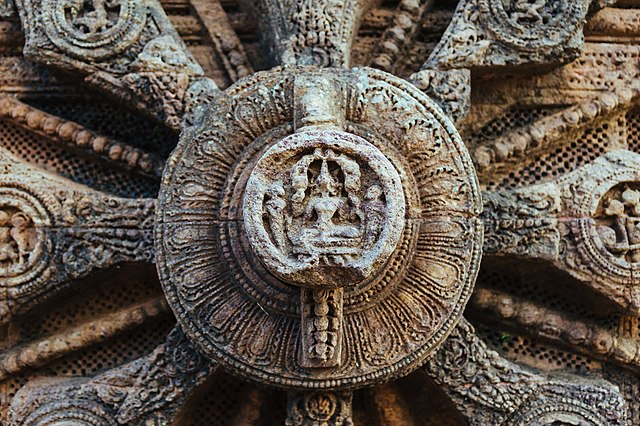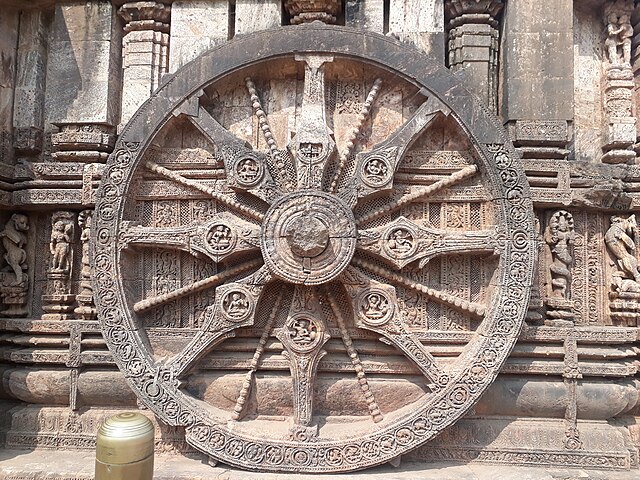Introduction to the Magnificent Sun Temple
Have you ever wondered what it feels like to witness a 13th-century masterpiece that seems to defy time itself? The Sun Temple at Konark in Odisha, India, stands as one of the most extraordinary examples of ancient Indian architecture and artistry. This isn’t just another temple – it’s a colossal stone chariot dedicated to Surya, the Sun God, that continues to mesmerize visitors from around the world.
Picture this: a massive temple designed as a chariot with 24 intricately carved wheels, pulled by seven galloping horses, all crafted from stone with such precision that it seems almost impossible for its era. The Sun Temple Konark isn’t merely a religious structure; it’s a testament to human creativity, engineering prowess, and artistic vision that flourished in medieval India.
Historical Background and Origins

King Narasimhadeva I and the Vision
The story of Konark begins with King Narasimhadeva I of the Eastern Ganga Dynasty, who ruled Kalinga (present-day Odisha) in the 13th century. Legend has it that the king conceived this magnificent temple as a tribute to Surya, the Sun God, possibly to commemorate his military victories or as an act of devotion.
But here’s where it gets interesting – the king didn’t just want any ordinary temple. He envisioned something that would capture the very essence of the sun’s journey across the sky. This ambitious dream required not just vast resources but also extraordinary artistic and engineering skills that would push the boundaries of what was possible in that era.
The 13th Century Construction Timeline
Construction of the temple began around 1250 CE and took approximately 12 years to complete. Can you imagine the dedication required to work on a single project for over a decade? Historical accounts suggest that over 1,200 artisans worked tirelessly to bring this vision to life, each contributing their expertise in sculpture, architecture, and engineering.
The temple was completed around 1262 CE, representing the pinnacle of Kalinga architecture. During its heyday, the main sanctum tower reportedly stood at a towering height of 229 feet, making it one of the tallest structures of its time in India.
Architectural Brilliance of Konark
The Chariot Design Concept
What makes Konark truly unique is its revolutionary design concept. Instead of following traditional temple architecture, the builders created a massive stone representation of Surya’s chariot. This wasn’t just symbolic – every element of the temple was designed to reflect this chariot theme.
The entire temple complex was conceived as a chariot moving from east to west, following the sun’s daily journey. This concept required incredible planning and precision, as every architectural element had to serve both functional and symbolic purposes.
Stone Wheels and Their Significance
The 24 Elaborate Wheels
The most striking feature of the Sun Temple has to be its 24 enormous wheels, each measuring about 12 feet in diameter. These aren’t just decorative elements – they’re functional sundials that can actually tell time! Each wheel is divided into eight spokes, and the shadows cast by these spokes indicate different hours of the day.
But there’s more to these wheels than meets the eye. The 24 wheels represent the 24 hours of a day, while their intricate carvings depict various aspects of life, love, and spirituality. Each wheel tells a story through its sculptures, making them like ancient comic books carved in stone.
Seven Horse Sculptures
The seven magnificent horses that appear to pull this stone chariot aren’t randomly chosen. In Hindu mythology, Surya’s chariot is pulled by seven horses, each representing a day of the week and a color of the rainbow. These horses, carved with incredible detail, seem to be in mid-gallop, creating an illusion of movement that’s simply breathtaking.
Artistic Excellence and Sculptures
Erotic Sculptures and Their Meaning
One aspect of Konark that often surprises visitors is the presence of erotic sculptures among its carvings. Before you raise an eyebrow, understand that these sculptures serve a deeper purpose than mere decoration. In ancient Indian philosophy, these representations symbolize the celebration of life in all its forms and the integration of the physical and spiritual realms.
These sculptures also reflect the tantric traditions and the concept of divine union. They’re artistic expressions of the belief that spiritual enlightenment encompasses all aspects of human experience, including sexuality, which was viewed as a natural and sacred part of life.
Religious and Mythological Carvings
Beyond the erotic sculptures, Konark is a treasure trove of religious and mythological art. The walls are adorned with intricate carvings depicting scenes from Hindu epics, celestial beings, musicians, dancers, and various deities. Each carving is so detailed that you could spend hours studying a single panel.
The sculptors didn’t just create static images – they brought stories to life in stone. You’ll find depictions of Lord Krishna’s adventures, scenes from the Ramayana, and various other mythological narratives that were central to the cultural consciousness of that era.
Engineering Marvels of the Temple
Magnetic Properties and Legends
Here’s where Konark gets really fascinating from an engineering perspective. Local legends speak of a massive magnet that was supposedly placed at the top of the main tower. This magnet was said to be so powerful that it could suspend iron objects in mid-air and even affected the compasses of ships sailing along the nearby coast.
While the main tower no longer exists, and the magnetic claims remain largely in the realm of legend, they point to the advanced understanding of materials and physics that the temple’s builders possessed. Whether or not these magnetic properties were real, the very concept shows remarkable scientific thinking for the 13th century.
Construction Techniques Used
The construction techniques employed at Konark were nothing short of revolutionary. The builders used a technique called “dry masonry,” where massive stone blocks were fitted together without mortar. This required incredible precision in cutting and shaping each stone block.
The temple also features an ingenious drainage system that has helped preserve the structure for over 750 years. The architects understood the importance of water management in a coastal location and incorporated features to deal with the high humidity and occasional storms.
UNESCO World Heritage Status
Recognition and Global Importance
In 1984, UNESCO recognized the Sun Temple Konark as a World Heritage Site, acknowledging its outstanding universal value to humanity. This recognition wasn’t just about the temple’s age or size – it was about its unique contribution to world architecture and art.
The UNESCO designation has helped bring international attention to Konark’s conservation needs and has facilitated various preservation efforts. It’s also put this incredible monument on the global tourism map, allowing people from all over the world to experience its magnificence.
Visiting the Sun Temple Today
Best Time to Visit
Planning a visit to Konark? The best time to experience this architectural marvel is between October and March when the weather is pleasant and conducive to exploration. The temple looks particularly stunning during sunrise and sunset when the golden light plays on its intricate carvings.
If you’re lucky enough to visit during the Konark Dance Festival (usually held in December), you’ll witness classical Indian dance performances against the backdrop of this ancient temple – an experience that’s truly magical.
Entry Fees and Timings
The temple is open to visitors from sunrise to sunset, typically from 6:00 AM to 8:00 PM. Entry fees are quite reasonable – Indian citizens pay around ₹30, while foreign tourists pay approximately ₹500. These fees contribute to the temple’s maintenance and preservation efforts.
Photography Guidelines
While photography is generally allowed in the temple complex, there might be restrictions in certain areas or for commercial photography. It’s always best to check with the authorities or your guide about current photography policies. Remember, the goal is to preserve this heritage site for future generations while allowing people to capture and share its beauty.
Cultural Significance in Modern Times

Even today, the Sun Temple Konark continues to play an important role in Odisha’s cultural identity. It appears on the ₹10 Indian currency note, symbolizing its national importance. The temple also inspires contemporary artists, architects, and designers who draw from its rich artistic heritage.
Local communities still consider the temple sacred, and various cultural events and festivals are organized here throughout the year. It serves as a bridge between India’s glorious past and its vibrant present, reminding us of the incredible artistic and engineering capabilities of our ancestors.
Preservation Efforts and Challenges
Preserving a 750-year-old structure comes with unique challenges. The temple faces threats from natural elements like coastal erosion, humidity, and occasional cyclones. Additionally, increasing tourist footfall, while economically beneficial, also poses conservation challenges.
The Archaeological Survey of India (ASI) has undertaken various conservation projects over the years. These include structural stabilization, stone conservation treatments, and environmental monitoring. International collaboration with UNESCO and other heritage organizations has also provided valuable expertise and resources for preservation efforts.
Modern technology is now being employed for conservation, including 3D documentation, laser scanning, and digital preservation techniques. These efforts ensure that even if physical deterioration occurs, the temple’s artistic and architectural details will be preserved for future study and appreciation.
Conclusion
The Sun Temple Konark stands as more than just an ancient monument – it’s a celebration of human creativity, devotion, and engineering excellence. From its innovative chariot design to its intricate sculptures, from its astronomical accuracy to its artistic brilliance, Konark represents the pinnacle of medieval Indian architecture.
As you stand before those massive stone wheels and marvel at the detailed carvings, you’re not just looking at art – you’re witnessing the dreams and aspirations of people who lived over 750 years ago. They created something so extraordinary that it continues to inspire and amaze us today.
Whether you’re an architecture enthusiast, a history buff, an art lover, or simply someone who appreciates beauty, the Sun Temple Konark offers an experience that’s both humbling and uplifting. It reminds us that true art transcends time, and that the human spirit’s capacity for creating beauty is truly limitless.
Frequently Asked Questions (FAQs)
1. Why is the Sun Temple Konark shaped like a chariot?
The temple is designed as a chariot to represent Surya’s (Sun God’s) celestial chariot that travels across the sky daily. This unique concept makes it different from traditional temple architecture and symbolizes the sun’s journey from east to west.
2. Can the stone wheels of Konark actually tell time?
Yes! The 24 wheels function as sundials. The shadows cast by the spokes of these wheels indicate different hours of the day, showcasing the advanced astronomical knowledge of the temple’s builders.
3. What happened to the main tower of the Sun Temple?
The main sanctum tower, which was reportedly 229 feet tall, collapsed sometime in the 19th century due to structural issues and natural deterioration. Today, only the audience hall (jagamohana) and some smaller structures remain intact.
4. Is photography allowed inside the Sun Temple Konark?
Yes, photography is generally allowed in most areas of the temple complex for personal use. However, there may be restrictions in certain sections, and commercial photography might require special permissions.
5. How long does it take to properly explore the Sun Temple?
To fully appreciate the temple’s architecture, sculptures, and historical significance, plan to spend at least 2-3 hours. If you’re interested in detailed exploration and photography, you might want to allocate half a day to truly absorb the magnificence of this architectural marvel.

